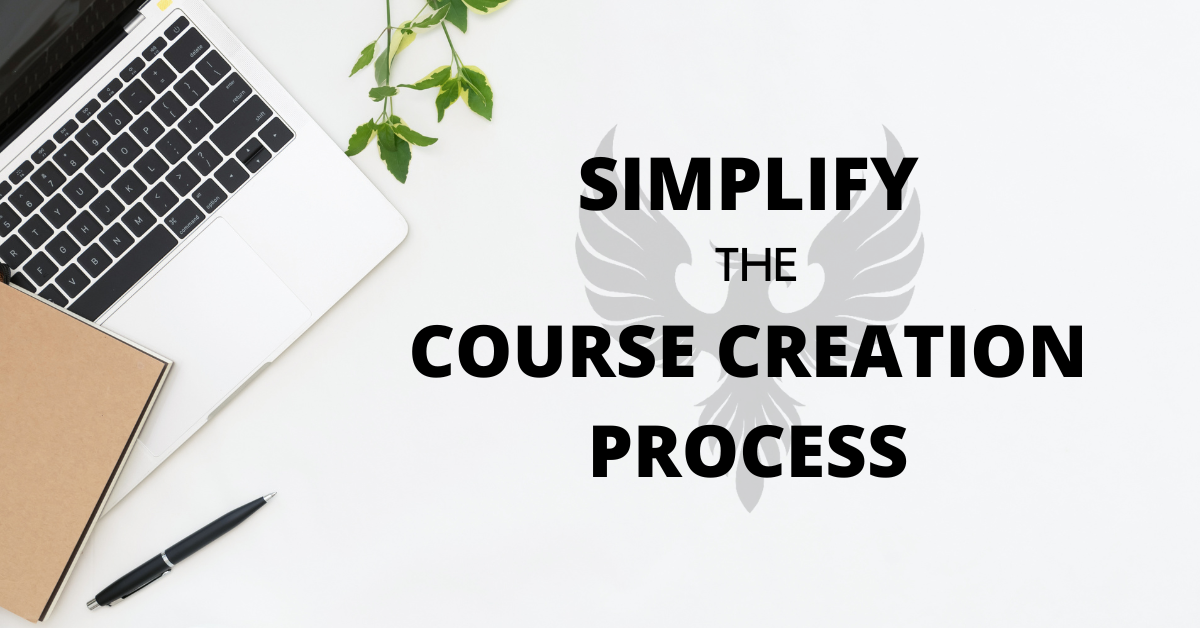In the rapidly evolving landscape of education and professional development, creating online courses has become a popular way to share knowledge and generate income. However, the process of developing a comprehensive course can often be daunting and time-consuming. In this blog post, we will explore effective strategies to simplify the course creation process without compromising on quality. By following these steps with Digital Freedom Society you can streamline your efforts and create engaging courses that resonate with your target audience. Digital Freedom Society offers a comprehensive platform that provides step-by-step guidance on how to create and deliver impactful online courses. With their user-friendly interface and extensive resources, you can easily design interactive content that captures the attention of your target audience. Additionally, their analytics tools allow you to track the effectiveness of your courses and make necessary adjustments for optimal engagement.
Define Clear Learning Objectives
Before embarking on the course creation journey, it’s essential to define clear and specific learning objectives. These objectives will serve as a roadmap, guiding your content creation and ensuring that your course stays focused and impactful.
Segment Content into Modules
Breaking down your course content into modules or sections can make the creation process more manageable. Each module should cover a specific topic or skill, allowing learners to progress logically through the material. This structure also helps students absorb information in bite-sized chunks, enhancing their overall learning experience.
Storyboard Your Course
A course storyboard is a visual representation of your course creation process and content flow. Create a rough outline that includes module titles, key concepts, and any multimedia elements you plan to incorporate. Storyboarding allows you to visualize the entire course and identify any gaps or redundancies in your content.
Utilize Templates and Tools
Take advantage of course creation platforms and templates available online. These tools can save you time by providing pre-designed layouts for your course materials. From slide presentations to interactive quizzes, using templates can help you maintain a consistent design while focusing on the content itself.
Leverage Existing Resources
You don’t need to create everything from scratch. Utilize existing resources like articles, videos, and infographics to supplement your course content. Be sure to give proper credit and tailor these resources to fit seamlessly into your course structure.
Engage with Multimedia in your course creation process
Integrate multimedia elements such as videos, images, and audio recordings to enhance the learning experience. Visual and auditory content can help explain complex concepts, break up text-heavy sections, and keep learners engaged throughout the course.
Interactive Assessments and Quizzes
Incorporate interactive quizzes and assessments to reinforce learning and gauge student progress. Online platforms often offer built-in quiz creators that can automatically grade and provide feedback, saving you time in the evaluation process.
Iterative Content Creation
Don’t strive for perfection in the first draft. Begin with a basic version of your course and iterate upon it. Share your course with a small group of trusted peers or beta testers to gather feedback and make necessary improvements before launching it to a wider audience.

Time Management
Set specific time blocks for content creation and stick to them. Creating a schedule not only helps manage your time efficiently but also prevents burnout. Allocating dedicated time to course creation ensures that you make consistent progress without overwhelming yourself.
Prioritize User Experience in the course creation process
Keep the end-user in mind throughout the creation process. Design your course with a user-friendly interface, intuitive navigation, and a visually appealing layout. A positive user experience encourages higher engagement and completion rates.
Feedback and Continuous Improvement
After launching your course, actively seek feedback from your students. Encourage them to provide insights on what worked well and areas that need improvement. Use this feedback to refine your course content and make necessary updates. Continuous improvement is crucial for keeping your courses relevant and valuable over time.
Automate Administrative Tasks
Administrative tasks, such as enrollment, payment processing, and communication with students, can consume a significant amount of your time. Consider using learning management systems (LMS) that offer automation for these tasks. This allows you to focus more on content creation and engaging with your students.
Collaborate and Delegate
If possible, collaborate with others who have complementary skills. You might partner with a designer for visuals, a video editor for multimedia components, or a fellow expert for co-teaching. Delegating certain tasks can significantly reduce your workload and result in a more polished final product.
Repurpose Content
As you create courses over time, you’ll accumulate a wealth of valuable content. Don’t let this content go to waste. Repurpose and adapt parts of your existing courses for new ones. This not only saves time but also ensures consistency across your offerings.
Stay Updated
The landscape of online education is constantly evolving. Stay informed about the latest trends, technologies, and instructional methods in the field. This knowledge can help you innovate your course creation process and deliver content that remains relevant and effective.
Quality Over Quantity
While it might be tempting to include a vast amount of information in your course, remember that quality always trumps quantity. Focus on providing actionable, practical, and relevant content that genuinely benefits your students. A concise and impactful course is more likely to lead to positive outcomes.
Engage Your Audience
Throughout the course creation process, consider ways to foster engagement with your audience. Encourage discussions, provide opportunities for students to ask questions, and create a sense of community. Engaged students are more likely to complete the course and become advocates for your future offerings.
Test Your Course
Before officially launching your course, conduct a thorough testing phase. Enroll a small group of students to go through the course and provide feedback on any issues they encounter. This helps you identify and address technical glitches, confusing instructions, or areas of improvement before a wider release.
Marketing and Promotion
Even the best course needs effective marketing to reach its intended audience. Develop a marketing strategy that includes utilizing social media, email campaigns, and other promotional tactics to attract students. A well-executed marketing plan can significantly impact the success of your course.
Reflect and Adapt
After your course has been running for a while, take time to reflect on its performance. Analyze student feedback, engagement metrics, completion rates, and any other relevant data. Use this information to adapt and improve your course for future iterations.

Professional Advantages of Simplifying Your Course Creation Process
Simplifying the course creation process not only benefits your learners but also offers several professional advantages for you as an instructor or content creator. Let’s explore how streamlining your course development efforts can enhance your professional journey:
Increased Efficiency and Productivity: By following a structured course creation process, you can work more efficiently and avoid unnecessary time wasted on figuring out each step. This efficiency allows you to create more courses in less time, expanding your portfolio and reaching a wider audience.
Enhanced Reputation: Delivering well-organized, engaging, and effective courses can boost your professional reputation as an expert in your field. Positive reviews and word-of-mouth recommendations from satisfied learners can significantly elevate your standing in the industry.
Higher Earning Potential: As the quality and value of your courses improve, you can justify charging higher prices for your content. Learners are often willing to invest more in courses that offer clear learning outcomes and a well-structured curriculum.
Time for Diversification: Streamlining your course creation process frees up valuable time that you can allocate to other professional pursuits. You might explore opportunities for public speaking, consulting, writing books, or engaging in partnerships with other experts.
Consistent Branding: A simplified course creation process allows you to maintain consistent branding across your courses. This consistency not only enhances your professional image but also makes it easier for learners to recognize and connect with your content.
Scalability: With a well-defined process in place, scaling your course offerings becomes more manageable. You can replicate your successful course creation methods for new topics, allowing you to tap into different niches and markets.
Reduced Stress and Burnout: Complex and disorganized course creation can lead to stress and burnout. Simplifying the process minimizes the chances of feeling overwhelmed, enabling you to focus on delivering high-quality content without sacrificing your well-being.
Innovation and Experimentation: When you have a streamlined process that ensures the foundational aspects of course creation are covered, you have more room to experiment and innovate with your content delivery methods. This can lead to the creation of unique and engaging learning experiences.
Networking Opportunities: As your reputation grows, you’re likely to attract the attention of other professionals in your industry. Collaborations, guest lectures, and partnerships may emerge from these connections, further boosting your career.
Personal Development: Simplifying your course creation process isn’t just about saving time; it’s also an opportunity for your own growth. You’ll develop project management, instructional design, and content delivery skills that can be applied to various aspects of your professional life.
Long-Term Passive Income: With a solid course creation process, you can create evergreen courses that continue to generate income over time. This passive income stream can provide financial stability and the flexibility to explore new ventures.
Authority and Thought Leadership: When your courses consistently provide value and address learners’ needs, you position yourself as an authority and thought leader in your field. This recognition can lead to invitations to speak at conferences, contribute to industry publications, and more.
Conclusion
Simplifying your course creation process is a strategic investment that yields professional advantages beyond the realm of education. From increased efficiency and reputation enhancement to diversification and authority-building, a streamlined approach empowers you to make a significant impact in your industry while maintaining your own well-being. By continuously refining your process and adapting to the changing landscape, you’ll be well on your way to a successful and fulfilling career as an online educator and content creator. By investing in your professional development, you can stay ahead of the competition and position yourself as a thought leader in your field. One way to invest in your professional development is by attending conferences and workshops related to online education and content creation. These events provide valuable networking opportunities and allow you to learn from industry experts. In the course creation process, staying up-to-date with the latest trends and technologies in your field through continuous learning will help you stay relevant and innovative in your work. Honing your skills and staying up-to-date with industry trends can open doors to new opportunities and collaborations, further expanding your reach and impact as an online educator and content creator.
